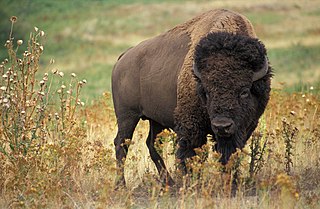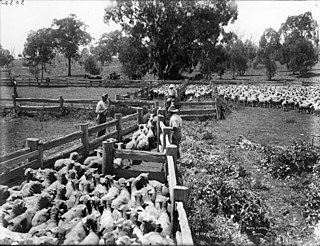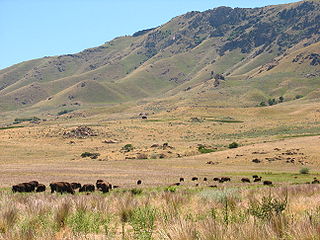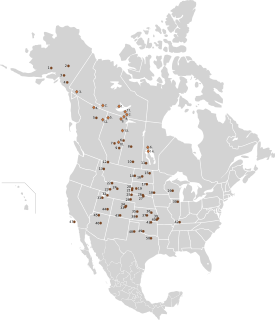Related Research Articles

Bison are large bovines in the genus Bison within the tribe Bovini. Two extant species and numerous extinct species are recognised.

The American bison, is an American species of bison that once roamed North America in vast herds. Bison are often called buffalo, though this term is also used to refer to other bovines. It is one of two extant species of bison, alongside the European bison. Its historical range, by 9000 BC, is described as the great bison belt, a tract of rich grassland that ran from Alaska to the Gulf of Mexico, east to the Atlantic Seaboard as far north as New York and south to Georgia and, according to some sources, further south to Florida, with sightings in North Carolina near Buffalo Ford on the Catawba River as late as 1750. It nearly became extinct by a combination of commercial hunting and slaughter in the 19th century and introduction of bovine diseases from domestic cattle. With a population in excess of 60 million in the late 18th century, the species was down to just 541 animals by 1889. Recovery efforts expanded in the mid-20th century, with a resurgence to roughly 31,000 wild bison today, largely restricted to a few national parks and reserves. Through multiple reintroductions, the species is now also freely roaming wild in some regions in the United States, Canada, and Mexico, with it also being introduced to Yakutia in Russia.

Wood Buffalo National Park is the largest national park of Canada at 44,807 km2 (17,300 sq mi). It is located in northeastern Alberta and the southern Northwest Territories. Larger in area than Switzerland, it is the second-largest national park in the world. The park was established in 1922 to protect the world's largest herd of free-roaming wood bison. They became hybridized after the introduction of plains bison. The population is currently estimated at about 3,000. It is one of two known nesting sites of whooping cranes.

The African buffalo is a large sub-Saharan African bovine. Syncerus caffer caffer, the Cape buffalo, is the typical subspecies, and the largest one, found in Southern and East Africa. S. c. nanus is the smallest subspecies, common in forest areas of Central and West Africa, while S. c. brachyceros is in West Africa and S. c. aequinoctialis is in the savannas of East Africa. The adult African buffalo's horns are its characteristic feature: they have fused bases, forming a continuous bone shield across the top of the head referred to as a "boss". It is widely regarded as one of the most dangerous animals on the African continent, and according to some estimates it gores, tramples, and kills over 200 people every year.

Mycobacterium bovis is a slow-growing aerobic bacterium and the causative agent of tuberculosis in cattle. It is related to Mycobacterium tuberculosis, the bacterium which causes tuberculosis in humans. M. bovis can jump the species barrier and cause tuberculosis-like infection in humans and other mammals.

Great Limpopo Transfrontier Park is a 35,000 km² peace park that is in the process of being formed. It will link the Limpopo National Park in Mozambique, Kruger National Park in South Africa, Gonarezhou National Park, Manjinji Pan Sanctuary and Malipati Safari Area in Zimbabwe, as well as the area between Kruger and Gonarezhou, the Sengwe communal land in Zimbabwe and the Makuleke region in South Africa.
Contagious bovine pleuropneumonia, is a contagious bacterial disease that afflicts the lungs of cattle, buffalo, zebu, and yaks.

Antelope Island, with an area of 42 square miles (109 km2), is the largest of ten islands located within the Great Salt Lake in the US state of Utah. The island lies in the southeastern portion of the lake, near Salt Lake City and Davis County, and becomes a peninsula when the lake is at extremely low levels. It is protected as Antelope Island State Park.

A bovid hybrid is a hybrid of two different members of the bovid family.

In biology, culling is the process of segregating organisms from a group according to desired or undesired characteristics. In animal breeding, it is the process of removing or segregating animals from a breeding stock based on specific trait. This is done to exaggerate desirable characteristics, or to remove undesirable characteristics by altering the genetic diversity of the population. For livestock and wildlife, culling often refers to the act of killing removed animals based on their individual characteristics, such as their sex or species membership, or as a means of preventing infectious disease transmission.

The wood bison or mountain bison, is a distinct northern subspecies or ecotype of the American bison. Its original range included much of the boreal forest regions of Alaska, Yukon, western Northwest Territories, northeastern British Columbia, northern Alberta, and northwestern Saskatchewan.

The Plains bison is one of two subspecies/ecotypes of the American bison, the other being the wood bison. A natural population of Plains bison survives in Yellowstone National Park and multiple smaller reintroduced herds of bison in many places in the United States as well as southern portions of the Canadian Prairies.
Battle at Kruger is an eight-minute amateur wildlife video that depicts a confrontation between a herd of Cape buffalo, a small group of young lions from a pride, and two crocodiles. The video was shot in September 2004 at the Transport Dam watering hole in Kruger National Park, South Africa, during a safari guided by Frank Watts. It was filmed by videographer David Budzinski and photographer Jason Schlosberg.

The Timbavati Private Nature Reserve is located at the border line between Hoedspruit and Acornhoek, north of the Sabi Sand Private Game Reserve on the western edge of Kruger National Park. Geographically and politically, Timbavati is located in Mpumalanga Province. In Xitsonga, the name 'Timbavati' means "the place where something sacred came down to Earth from the Heavens", and refers to the rare white lions of Timbavati.

The Arabian oryx, also called the white oryx, was extinct in the wild as of 1972, but was reintroduced to the wild starting in 1982. Initial reintroduction was primarily from two herds: the "World Herd" originally started at the Phoenix Zoo in 1963 from only nine oryx and the Saudi Arabian herd started in 1986 from private collections and some "World Herd" stock by the Saudi National Wildlife Research Center (NWRC). As of 2009 there have been reintroductions in Oman, Saudi Arabia, Israel, the United Arab Emirates, and Jordan, and as of 2013 the IUCN Red List classifies the species as vulnerable.

Bison hunting was an activity fundamental to the economy and society of the Plains Indians peoples who inhabited the vast grasslands on the Interior Plains of North America, prior to the animal's near-extinction in the late nineteenth century following US expansion into the West. Bison hunting was an important spiritual practice and source of material for these groups, especially after the European introduction of the horse in the 16th through 18th centuries enabled new hunting techniques. The species' dramatic decline was the result of habitat loss due to the expansion of ranching and farming in western North America, industrial-scale hunting practiced by non-indigenous hunters, increased indigenous hunting pressure due to non-indigenous demand for bison hides and meat, and cases of deliberate policy by settler governments to destroy the food source of the Indigenous peoples during times of conflict.

The Antelope Island bison herd is in Antelope Island State Park in Great Salt Lake, Utah. The semi–free-ranging population of American bison has been in existence on Antelope Island since 1893. The island was named for the pronghorn antelope that John C. Frémont and Kit Carson found there when they explored the Great Salt Lake. Bison were later introduced. The herd is significant because it is one of the largest and oldest publicly owned bison herds in the nation. It is one of the two bison herds managed by the State of Utah, the other being the Henry Mountains bison herd. The Antelope Island bison herd currently numbers between 550 and 700 individuals. Other large free-ranging, publicly controlled herds of bison in the United States include the Yellowstone Park bison herd, the herd in Custer State Park, South Dakota, the Henry Mountains bison herd in south-central Utah, and the herd at Wind Cave National Park in South Dakota. In addition, though the bison on Antelope Island are Prairie bison, which was the most common bison subspecies in North America, the bison have a distinct genetic heritage from many of the other bison herds in the United States and they are considered to be desirable as part of the breeding and foundation stock for other bison herds, because of their separate genetic heritage and some of the distinct genetic markers that are found in the population.

Throughout the 18th and 19th centuries, the plains bison and wood bison in Canada were hunted by nomadic indigenous hunters and white hunters alike. By the 1850s, the bison was nearly extinct, spurring a movement to save the few herds that remained. Federal government wildlife policy evolved from preservation of wilderness to utilitarian, scientific conservation and management of bison populations. The goals of these policies were often contradictory: to simultaneously preserve wildlife, promote recreation, commercialize the bison, and assert state control over Aboriginal Canadians. Bison conservation efforts were shaped by the federal government's colonialist and modernist approach to Canada's North, the management of national parks and reserves, and the influence of scientific knowledge.
Vanessa Olivia Ezenwa is an American ecologist who is a Professor at the Odum School of Ecology at the University of Georgia. Her research considers the ecology of infectious diseases amongst animal populations. In 2020, she was selected by The Community of Scholars as one of the most Inspiring Black scientists in the United States.
The conservation of bison in North America is an ongoing, diverse effort to bring American bison back from the brink of extinction. Plains bison, a subspecies, are a keystone species in the North American Great Plains. Bison are a species of conservation concern in part because they suffered a severe population bottleneck at the end of the 19th century. The near decimation of the species during the 1800s unraveled fundamental ties between bison, grassland ecosystems, and indigenous peoples’ cultures and livelihoods. English speakers used the word buffalo for this animal when they arrived. Bison was used as the scientific term to distinguish them from the true buffalo. Buffalo is commonly used as it continues to hold cultural significance, particularly for Indigenous people. Recovery began in the late 1800s with a handful of individuals independently saving the last surviving bison. Dedicated restoration efforts in the 1900s bolstered bison numbers though they still exist in mostly small and isolated populations. Expansion of the understanding of bison ecology and management is ongoing.
References
- ↑ John Frederick Walker; Rolf Hochhuth; Albert Schweitzer (1964). A Certain Curve of Horn. Grove Press. ISBN 9780802140685 – via Google Books.
- ↑ "Tuberculosis". Agricultural Research Council. Archived from the original on 11 June 2006.
- ↑ AVIVA Archived 12 May 2008 at the Wayback Machine [ dead link ]
- "Buffalo Saviour". Mnet. Archived from the original on 4 September 2012 – via archive.today.